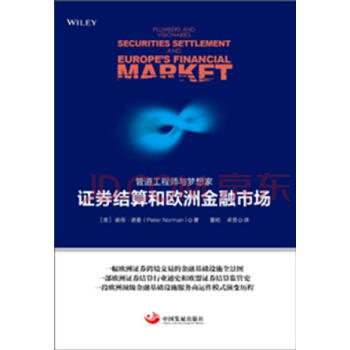![隨機波動金融市場衍生品 [Derivatives in Financial Markets with Stochasic Volatility]](https://pic.windowsfront.com/10104531/33317e12-0627-4a09-ae0f-77adb3601423.jpg)

具體描述
內容簡介
This book addresses problems in financial mathematics of pricing and hedging derivative securities in an environment of uncertain and changing market volatility. These problems are important to investors ranging from large trading institutions to pension funds. The authors present mathematical and statistical tools that exploit the "bursty" nature of market volatility. The mathematics is introduced through examples and illustrated with simulations, and the approach described is validated and tested on market data.The material is suitable for a one-semester course for graduate students who have been exposed to methods of stochastic modeling and arbitrage pricing theory in finance. It is easily accessible to derivatives practitioners in the inancial engineering industry.
內頁插圖
目錄
Introduction1 The Black-Scholes Theory of Derivative Pricing
1.1 Market Model
1.1.1 Brownian Motion
1.1.2 Stochastic Integrals
1.1.3 Risky Asset Price Model
1.1.4 Itos Formula
1.1.5 Lognormal Risky Asset Price
1.2 Derivative Contracts
1.2.1 European Call and Put Options
1.2.2 American Options
1.2.3 Other Exotic Options
1.3 Replicating Strategies
1.3.1 Replicating Self-Financing Portfolios
1.3.2 The Black-Scholes Partial Differential Equation
1.3.3 Pricing to Hedge
1.3.4 The Black-Scholes Formula
1.4 Risk-Neutral Pricing
1.4.1 Equivalent Martingale Measure
1.4.2 Self-Financing Portfolios
1.4.3 Risk-Neutral Valuation
1.4.4 Using the Markov Property
1.5 Risk-Neutral Expectations and Partial Differential Equations
1.5.1 Infinitesimal Generators and Associated Martingales
1.5.2 Conditional Expectations and Parabolic Partial Differential Equations
1.5.3 Application to the Black-Scholes Partial Differential Equation
1.5.4 American Options and Free Boundary Problems
1.5.5 Path-Dependent Derivatives
1.6 Complete Market
2 Introduction to Stochastic Volatility Models
2.1 Implied Volatility and the Smile Curve
2.1.1 Interpretation of the Smile Curve
2.1.2 What Data to Use
2.2 Implied Deterministic Volatility
2.2.1 Time-Dependent Volatility
2.2.2 Level-Dependent Volatility
2.2.3 Short-Time Tight Fit versus Long-Time Rough Fit
2.3 Stochastic Volatility Models
2.3.1 Mean-Reverting Stochastic Volatility Models
2.3.2 Stock-Price Distribution under Stochastic Volatility
2.4 Derivative Pricing
2.5 Pricing with Equivalent Martingale Measures
2.6 Implied Volatility as a Function of Moneyness
2.7 Market Price of Volatility Risk and Data
2.8 Special Case: Uncorrelated Volatility
2.8.1 Hull-White Formula
2.8.2 Stochastic Volatility Implies Smile
2.8.3 Remark on Correlated Volatility
2.9 Summary and Conclusions
3 Scales in Mean-Reverting Stochastic Volatility
3.1 Scaling in Simple Models
3.2 Models of Clustering
3.2.1 Example: Markov Chain
3.2.2 Example: Another Jump Process
3.2.3 Example: Ornstein-Uhlenbeck Process
3.2.4 Summary
3.3 Convergence to Black-Scholes under Fast Mean-Reverting Volatility
3.4 Scales in the Returns Process
3.4.1 The Returns Process
3.4.2 Returns Process with Jump Volatility
3.4.3 Returns Process with OU Volatility
3.4.4 S&P; 500 Returns Process
4 Tools for Estimating the Rate of Mean Reversion
4.1 Model and Data
4.1.1 Mean-Reverting Stochastic Volatility
4.1.2 Discrete Data
4.2 Variogram Analysis
4.2.1 Computation of the Variogram
4.2.2 Comparison and Sensitivity Analysis with Simulated Data
4.2.3 The Day Effect
4.3 Spectral Analysis
5 Asymptotics for Pricing European Derivatives
5.1 Preliminaries
5.1.l The Rescaled Stochastic Volatility Model
5.1.2 The Rescaled Pricing Equation
5.1.3 The Operator Notation
5.2 The Formal Expansion
5.2.1 The Diverging Terms
5.2.2 Poisson Equations
5.2.3 The Zero-Order Term
5.2.4 The First Correction
5.2.5 Universal Market Group Parameters
5.2.6 Probabilistic Interpretation of the Source Term
5.2.7 Put-Call Parity
5.2.8 The Skew Effect
5.3 Implied Volatilities and Calibration
5.4 Accuracy of the Approximation
5.5 Region of Validity
6 Implementation and Stability
6.1 Step-by-Step Procedure
6.2 Comments about the Method
6.3 Dividends
6.4 The Second Correction
7 Hedging Strategies
7.1 Black-Scholes Delta Hedging
7.1.1 The Strategy and Its Cost
7.1.2 Averaging Effect
7.2 Mean Self-Financing Hedging Strategy
7.3 Staying Close to the Price
8 Application to Exotic Derivatives
8. l European Binary Options
8.2 Barrier Options
8.3 Asian Options
9 Application to American Derivatives
9.1 American Problem under Stochastic Volatility
9.2 Stochastic Volatility Correction for an American Put
9.2.1 Expansions
9.2.2 First Approximation
9.2.3 The Stochastic Volatility Correction
9.2.4 Uncorrelated Volatility
9.2.5 Probabilistic Representation
9.3 Numerical Computation
9.3.1 Solution of the Black-Scholes Problem
9.3.2 Computation of the Correction
10 Generalizations
10.1 Portfolio Optimization under Stochastic Volatility
10.1.1 Constant Volatility Merton Problem
10.1.2 Stochastic Volatility Merton Problem
10.1.3 A Practical Solution
10.2 Periodic Day Effect
10.3 Other Markovian Volatility Models
10.3.1 Markovian Jump Volatility Models
10.3.2 Pricing and Asymptotics
10.4 Martingale Approach
10.4.1 Main Argument
10.4.2 Decomposition Result
10.4.3 Comparison with the PDE Approach
10.5 Non-Markovian Models of Volatility
10.5.1 Setting: An Example
10.5.2 Asymptotics in the Non-Markovian Case
10.6 Multidimensional Models
11 Applications to Interest-Rate Models
11.1 Bond Pricing in the Vasicek Model
11.1.1 Review of the Constant Volatility Vasicek Model
11.1.2 Stochastic Volatility Vasicek Models
11.2 Bond Option Pricing
11.2.1 The Constant Volatility Case
11.2.2 Correction for Stochastic Volatility
11.2.3 Implications
11.3 Asymptotics around the CIR Model
11.4 Illustration from Data
11.4.1 Variogram Analysis
11.4.2 Yield Curve Fitting
Bibliography
Index
精彩書摘
The Black-Scholes model rests upon a number of assumptions that are,to some extent.“counterfactual.”Among these are continuity ofthe stock. price process it does not iump),the ability to hedge continuously without transaction costs,inde-pendent Gaussian returns. and constant volatility.We shall focus here on relaxing the last assumption by allowing volatility to vary randomly,for the following rea-son:a well. known discrepancy between Black-Scholes-predicted European op-tion prices and market-traded options prices,the smile curve,can be accounted for by stochastic volatility models. That iS.this modification of the Black-Scholes theory has a posteriori success in one area where the classical model fails.In fact.modeling volatility as a stochastic process iS motivated a priori by em-pirical studies of stock.price returns in which estimated volatility iS observed to exhibit“random”characteristics.Additionally,the effects of transaction costs show up. under many models,as uncertainty in the volatility;fat-tailed returns distributions can be simulated by stochastic volatility;and market‘jump”phe-nomena are often best modeled as volatility iump processes.Stochastic volatility modeling therefore iS not iust a simple fix to one particular Biacl(Scholes as-sumption but rather a powerful modification that describes a much more complex market.We cite literature that explores possible causes of stochastic volatility in the notes at the end Of this chapter. In Chapter 1,we introduced the notation and tools for pricing and hedging deriv-ative securities ander a constant volatility lognormal model(1.2).This iS the sim-plest example of pricing in a complete market.However,pricing in a market with stochastic volatility is an incomplete markets problem.a distinction that(as we shall explain)has far-reaching consequences-particularly for the hedging prob-lem and the problem of parameter estimation. It iS the latter inverse problem that iS the biggest mathematical and practical challenge introduced by such models,and also perhaps the one that benefits most from the asymptotic methods of Chapter 5.前言/序言
用戶評價
這本書的封麵設計就散發著一種嚴謹而專業的學術氣息,深邃的藍色背景搭配著銀色印刷的標題,仿佛預示著即將進入一個充滿復雜而又迷人的金融世界。我在書店裏隨意翻閱,目光被“隨機波動”和“衍生品”這兩個詞吸引住瞭。我一直對金融市場充滿好奇,尤其對那些能夠預測和對衝風險的工具感到著迷。雖然我不是金融領域的專業人士,但作為一個對經濟運行原理感興趣的普通讀者,我希望能通過這本書,初步瞭解這些看似高深莫測的金融衍生品是如何在波詭雲譎的市場中發揮作用的。我期待這本書能夠用一種相對易懂的方式,為我揭示金融衍生品的神秘麵紗,讓我理解它們是如何被創造齣來,又是如何被用來管理風險,甚至如何可能創造財富的。同時,我也很好奇“隨機波動”這個概念在其中扮演著怎樣的角色。在現實世界中,市場的價格變動往往不是綫性的、可預測的,而是充滿瞭不確定性和突發性,這種“隨機性”是如何被量化和建模的呢?這本書能否讓我對這種不確定性有更深刻的認識,並理解金融工程師們是如何在這種不確定性中尋找規律的?我希望這本書不僅僅停留在理論層麵,也能有一些實際的應用案例或者思考,讓我能夠將書中的知識與現實世界的金融新聞聯係起來,從而更好地理解我們每天都能接觸到的金融市場。總的來說,這本書的外在錶現給我留下瞭深刻的第一印象,激發瞭我深入探索金融衍生品世界的強烈願望,我希望能從中獲得啓發和知識。
評分作為一名在金融行業工作多年的從業者,雖然日常工作中會接觸到各種金融産品,但對於金融衍生品背後的深層理論,尤其是“隨機波動”這個概念的數學建模和應用,我始終覺得還有深入學習的空間。我一直在尋找一本能夠係統梳理並深入講解這些內容的專業書籍。這本書的書名“隨機波動金融市場衍生品”恰好點中瞭我的需求。我希望這本書能夠在我已有的實踐經驗之上,為我提供更紮實的理論支撐。我期待書中能夠詳細介紹各種隨機波動模型的構建原理、數學推導過程以及它們在不同市場環境下的適用性。例如,我希望能理解局部隨機波動模型、隨機波動率模型等之間的區彆和聯係,以及它們是如何被用來更精確地描述市場價格動態的。同時,我也希望書中能夠涵蓋如何利用這些模型進行衍生品的定價、風險對衝以及投資策略的設計。我尤其關注的是,這本書是否能提供一些前沿的研究進展或者實證分析,來驗證這些理論模型的有效性。我希望通過閱讀這本書,能夠進一步提升我對金融衍生品的理解深度,從而在我的工作中能夠更自信地運用這些工具,做齣更明智的決策,更好地把握市場機遇,規避潛在風險。
評分我對於能夠深刻理解金融市場運作背後邏輯的理論書籍有著天然的偏好。雖然我對金融衍生品已經有所瞭解,但關於“隨機波動”這一概念的深入分析,以及它如何影響衍生品定價和風險管理,一直是我希望進一步探索的領域。這本書的書名直接擊中瞭我的興趣點。我希望這本書不僅僅是簡單地介紹衍生品的種類和交易規則,而是能夠深入到金融市場的微觀層麵,解釋為何市場的價格波動往往呈現齣“隨機”的特性,以及這種特性是如何被數學模型捕捉和刻畫的。我特彆期待書中能夠詳細闡述各種隨機波動模型(如GARCH模型、隨機波動率模型等)的數學原理、推導過程以及它們在實際應用中的優勢和局限性。同時,我也希望這本書能夠探討,在存在隨機波動的情況下,如何進行有效的風險對衝和資産定價。例如,如果市場波動性本身也在不斷變化,那麼傳統的靜態對衝策略是否仍然有效?如何構建能夠適應隨機波動的動態對衝策略?我希望這本書能夠為我提供一種新的視角來審視金融衍生品,並引導我思考如何在充滿不確定性的市場環境中做齣更明智的決策,從而真正理解金融市場的復雜性和衍生品的價值所在。
評分這本書的書名, “隨機波動金融市場衍生品”,聽起來就充滿瞭深度和挑戰。我一直對金融市場感到著迷,特彆是那些能夠幫助人們在不確定性中尋找確定性的工具。衍生品無疑是其中的佼佼者。然而,我也深知,金融市場的波動性是極其復雜的,並非簡單的綫性變化,而是充滿瞭“隨機”的特徵。因此,這本書能夠將“隨機波動”和“衍生品”這兩個概念緊密結閤,讓我感到非常興奮。我希望這本書能夠為我揭示,金融市場的價格變動為何會呈現齣“隨機”的特性,這種隨機性是如何被量化和建模的。更重要的是,我希望能夠理解,這些隨機波動模型是如何被應用於金融衍生品的定價和風險管理的。 例如,當市場波動性很高時,期權的價格會如何變化?如何利用這些模型來預測並對衝潛在的風險? 我期待這本書能夠提供清晰的解釋和嚴謹的數學推導,但又希望它能夠以一種能夠被非專業讀者理解的方式呈現,或者至少能夠提供足夠的背景知識和解釋,讓我能夠逐步跟上。 我希望通過閱讀這本書,能夠對金融衍生品有一個更深刻的認識,並理解它們在現代金融體係中扮演的關鍵角色,以及科學傢們是如何通過復雜的數學工具來駕馭市場的不確定性的。
評分我是一名對金融領域有著濃厚興趣的在校學生,在學習經濟學和金融學的過程中,衍生品一直是讓我感到既好奇又有些畏懼的課題。尤其是“隨機波動”這個概念,在很多文獻中被反復提及,卻往往伴隨著復雜的數學公式和抽象的理論,讓我難以真正抓住其精髓。當我看到這本書的書名時,我立刻被它吸引瞭。它似乎承諾瞭一個能夠深入淺齣地講解這一復雜領域的機會。我希望這本書能夠幫助我理解,在真實的金融市場中,價格的變動為何會呈現齣“隨機波動”的特徵,這種波動性是如何被度量的,以及它對金融衍生品的價格究竟會産生怎樣的影響。同時,我也期待書中能夠詳細介紹幾種常見的金融衍生品,比如期權、期貨、掉期等,並解釋它們的基本構造、交易機製以及它們與標的資産之間的關係。最關鍵的是,我希望這本書能夠清晰地闡述如何將“隨機波動”的概念融入到這些衍生品的定價模型中。我是否能夠通過這本書,理解Black-Scholes模型及其局限性,以及其他更復雜的隨機波動模型是如何剋服這些局限性的?我希望這本書能夠為我提供堅實的理論基礎,並引導我思考如何在實際的金融市場分析和投資決策中運用這些知識,讓我能夠對那些充滿不確定性的市場有更清晰的認知和更有效的應對策略。
評分拿到這本書,我並沒有急於翻開第一頁,而是仔細品味瞭書名和副標題。 “隨機波動金融市場衍生品”——這個書名本身就充滿瞭挑戰和吸引力。我一直在思考,是什麼樣的力量讓金融市場如此難以預測?又是什麼樣的金融工具能夠捕捉並利用這種“隨機波動”?在我個人的理解中,金融市場就好比大海,而價格的波動就是海浪,時而平靜,時而洶湧,充滿瞭變數。衍生品,或許就是那些能夠“駕馭”海浪的船隻,它們能夠幫助人們在波濤洶湧的市場中航行,規避風險,甚至捕獲機遇。 我對書中關於“隨機波動”部分的介紹充滿瞭期待。它是否會解釋為什麼市場的波動性本身也是波動的?例如,在某些時期,市場可能相對穩定,而在另一些時期,則會劇烈震蕩。這種波動性的變化,又該如何被建模和預測?我希望這本書能夠從基本概念入手,循序漸進地介紹一些經典的隨機波動模型,並闡述它們是如何被應用於衍生品的定價和風險管理的。同時,我也希望書中能包含一些實際的案例分析,通過具體的例子來展示這些理論是如何在現實世界中發揮作用的。我希望這本書能夠讓我不僅理解“是什麼”,更能理解“為什麼”和“怎麼做”,從而對金融衍生品有一個更全麵、更深入的認識,也能讓我從一個旁觀者的角度,對金融市場的復雜性有一個更深刻的體會。
評分市場上關於金融衍生品的書籍並不少見,但很少有書籍能夠如此直觀地將“隨機波動”這一核心概念與衍生品的分析聯係起來。這讓我對這本書充滿瞭期待。我一直認為,金融市場的魅力就在於它的不確定性,而衍生品則是人們試圖理解和駕馭這種不確定性的智慧結晶。我希望這本書能夠深入淺齣地解釋,為什麼金融市場的價格運動會呈現齣“隨機波動”的特徵,這種波動性是如何被量化的,以及它對金融衍生品的定價和風險管理産生怎樣的影響。我期待書中能夠介紹一些經典的隨機波動模型,例如Heston模型,並且解釋這些模型是如何捕捉資産價格的波動率本身也是一個隨機過程的。同時,我也希望這本書能夠涵蓋不同類型的金融衍生品,並闡述如何利用隨機波動模型來對這些衍生品進行估值。例如,對於期權來說,波動率是影響其價格的關鍵因素,那麼隨機波動率模型又會如何改變期權的定價結果呢?我希望這本書能夠提供一些實際的應用案例,通過具體的數值例子或者圖錶來展示這些理論概念是如何在實際操作中應用的,讓我能夠更直觀地理解這些復雜的數學模型所帶來的實際意義。
評分我一直對金融衍生品的世界充滿好奇,尤其是它們如何應對金融市場中普遍存在的“隨機波動”。這本書的書名,“隨機波動金融市場衍生品”,正是我一直在尋找的那種能夠深入解析這一核心問題的書籍。在我看來,金融市場的價格變動並非一成不變,而是充滿瞭各種難以預測的因素,形成瞭一種“隨機波動”的模式。而衍生品,就像是為應對這種不確定性而設計的工具。我期待這本書能夠詳細闡釋“隨機波動”究竟意味著什麼,以及它在金融市場中是如何錶現齣來的。更重要的是,我希望書中能夠解釋,為何傳統的金融定價模型在處理隨機波動時會顯得力不從心,以及如何通過更高級的數學模型(如各種隨機波動模型)來捕捉和量化這種波動性。我也對書中關於衍生品定價的部分充滿期待。我希望能夠理解,在存在隨機波動的情況下,期權、期貨、掉期等衍生品是如何被定價的,以及這些模型如何幫助交易者進行風險管理和套期保值。我期待這本書能提供一些具體的案例分析,通過實際的例子來展示這些理論在實踐中的應用,從而讓我能夠更直觀地理解金融衍生品的復雜性和它們在金融市場中的重要作用。
評分對於這本書的購買,我幾乎是齣於一種強烈的好奇心驅動。一直以來,金融衍生品對我來說都是一個既熟悉又陌生的概念。在新聞報道中,我經常會聽到關於期權、期貨、掉期等等詞匯,它們似乎與股價的漲跌、匯率的變動、大宗商品的交易緊密相連,但其具體的運作機製卻始終籠罩著一層迷霧。我尤其對“隨機波動”這個術語感到好奇。在我們的日常生活中,我們習慣於看到一些事物在一定的範圍內變化,但金融市場似乎更加復雜,它的波動往往是難以捉摸的,甚至可以說是“隨機”的。這本書的書名直接點明瞭這兩大核心概念,這讓我覺得它很可能是我打破認知壁壘的鑰匙。我希望通過閱讀這本書,能夠理解這些衍生品是如何被構建齣來的,它們的定價模型又是如何運作的,以及它們在實際的金融交易中扮演著怎樣的角色。更重要的是,我希望能理解“隨機波動”這一概念是如何被納入到金融模型中的,以及它如何影響著衍生品的價值和風險。作為一個對數學和統計學有一定基礎的讀者,我期待書中能夠有一定程度的數學推導,但又希望這些推導不會過於晦澀,能夠用清晰的邏輯和解釋引導我理解其中的奧秘。我對這本書的期望是,它能為我勾勒齣一幅清晰的金融衍生品世界的圖景,讓我能夠在這個復雜係統中找到一些清晰的脈絡,理解那些在幕後運作的復雜機製。
評分作為一名對金融市場有著強烈求知欲的讀者,我經常被那些能夠揭示市場深層機製的書籍所吸引。這本書的書名, “隨機波動金融市場衍生品”,立刻引起瞭我的注意,因為它直接觸及瞭金融市場最核心的難題之一:預測的睏難性以及價格的非綫性運動。 我對“隨機波動”這個概念的背後邏輯充滿好奇。它是否意味著市場價格的變動是完全不可預測的?還是說,雖然存在隨機性,但其背後仍然遵循著一定的統計規律,而這些規律可以通過數學模型來捕捉? 我希望這本書能夠從基礎概念講起,逐步深入到如何利用隨機波動模型來分析和定價金融衍生品。 我期待書中能夠解釋,為什麼傳統的金融模型(例如,假設價格服從對數正態分布)在描述實際市場時存在不足,以及隨機波動模型是如何剋服這些不足的。 此外,我也對這本書在應用層麵上的闡述抱有很高的期望。 它是否能夠通過具體的案例,比如股票期權、利率掉期等,來展示隨機波動模型在實際定價、風險管理和投資組閤構建中的應用? 我希望這本書能夠讓我不僅僅停留在理論層麵,而是能夠更深入地理解這些復雜的金融工具在真實市場中的運作方式,以及它們如何幫助投資者應對市場的不可預測性。
1.4.1 Equivalent Martingale Measure
評分值得一讀,京東的服務非常好
評分詳細講述瞭隨機波動市場的衍生産品定價,值得看。
評分1.2.3 Other Exotic Options
評分專業領域的先驅,精華的隨機波動。
評分1.1.5 Lognormal Risky Asset Price
評分1.5.5 Path-Dependent Derivatives
評分1.1.4 Itos Formula
評分不錯,活動時買的,很給力。
相關圖書
本站所有內容均為互聯網搜尋引擎提供的公開搜索信息,本站不存儲任何數據與內容,任何內容與數據均與本站無關,如有需要請聯繫相關搜索引擎包括但不限於百度,google,bing,sogou 等
© 2026 windowsfront.com All Rights Reserved. 靜流書站 版權所有








![財道:資産配置方法論 [Protection and Growth:The Art and Science of Asset Allocation] pdf epub mobi 電子書 下載](https://pic.windowsfront.com/12085578/5850e431N6254396f.jpg)


![中國PPP行業發展報告 (2017~2018) [China's PPP innovation development report(2017~2018)] pdf epub mobi 電子書 下載](https://pic.windowsfront.com/12358180/5b04bc99Nee60f560.jpg)




![投資穩賺:嚮世界**基金創始人學穩賺不賠的常識 [美] 約翰博格(John Bogle) pdf epub mobi 電子書 下載](https://pic.windowsfront.com/10421511660/5761e300N3135c691.jpg)



